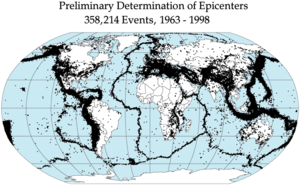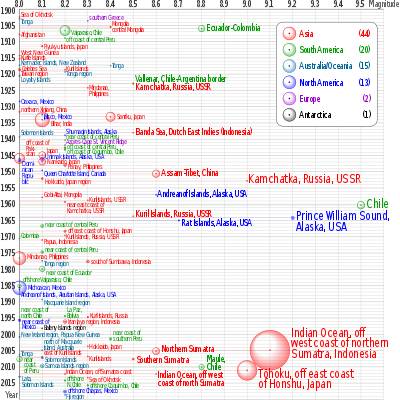Private Library of Simamora, Helmut Todo Tua
Environment, Research and Development Agency
Samosir Regency Government of North Sumatera Province
INDONESIA
Berikut merupakan kutipan ilmiah yang digunakan Penulis sebagai referensi pribadi.
BELAJAR TENTANG MENGENAL GEMPA BUMI
Earthquakes can be recorded by seismometers up to great distances, because seismic waves travel through the whole Earth's interior. The absolute magnitude of a quake is conventionally reported by numbers on the Moment magnitude scale (formerly Richter scale, magnitude 7 causing serious damage over large areas), whereas the felt magnitude is reported using the modified Mercalli intensity scale (intensity II–XII).
Every tremor produces different types of seismic waves, which travel through rock with different velocities:
- Longitudinal P-waves (shock- or pressure waves)
- Transverse S-waves (both body waves)
- Surface waves — (Rayleigh and Love waves)
Propagation velocity of the seismic waves ranges from approx. 3 km/s up to 13 km/s, depending on the density and elasticity of the medium. In the Earth's interior the shock- or P waves travel much faster than the S waves (approx. relation 1.7 : 1). The differences in travel time from the epicentre to the observatory are a measure of the distance and can be used to image both sources of quakes and structures within the Earth. Also the depth of the hypocenter can be computed roughly.
In solid rock P-waves travel at about 6 to 7 km per second; the velocity increases within the deep mantle to ~13 km/s. The velocity of S-waves ranges from 2–3 km/s in light sediments and 4–5 km/s in the Earth's crust up to 7 km/s in the deep mantle. As a consequence, the first waves of a distant earthquake arrive at an observatory via the Earth's mantle.
On average, the kilometer distance to the earthquake is the number of seconds between the P and S wave times 8.[44] Slight deviations are caused by inhomogeneities of subsurface structure. By such analyses of seismograms the Earth's core was located in 1913 byBeno Gutenberg.
Earthquakes are not only categorized by their magnitude but also by the place where they occur. The world is divided into 754 Flinn-Engdahl regions (F-E regions), which are based on political and geographical boundaries as well as seismic activity. More active zones are divided into smaller F-E regions whereas less active zones belong to larger F-E regions.
Standard reporting of earthquakes includes its magnitude, date and time of occurrence, geographic coordinates of its epicenter, depth of the epicenter, geographical region, distances to population centers, location uncertainty, a number of parameters that are included in USGS earthquake reports (number of stations reporting, number of observations, etc.), and a unique event ID.[45]
This search form is limited to 20,000 results. If your search criteria returns more than 20,000 results, an error message will be displayed rather than the expected results. In this case, input parameters should be narrowed in order to successfully complete the search.



- ^ "Earthquake FAQ". Crustal.ucsb.edu. Retrieved 2011-07-24.
- ^ Spence, William; S. A. Sipkin, G. L. Choy (1989). "Measuring the Size of an Earthquake". United States Geological Survey. Retrieved 2006-11-03.
- ^ Wyss, M. (1979). "Estimating expectable maximum magnitude of earthquakes from fault dimensions". Geology 7 (7): 336–340.Bibcode:1979Geo.....7..336W. doi:10.1130/0091-7613(1979)7<336:EMEMOE>2.0.CO;2.
- ^ Sibson R. H. (1982) "Fault Zone Models, Heat Flow, and the Depth Distribution of Earthquakes in the Continental Crust of the United States", Bulletin of the Seismological Society of America, Vol 72, No. 1, pp. 151–163
- ^ Sibson, R. H. (2002) "Geology of the crustal earthquake source" International handbook of earthquake and engineering seismology, Volume 1, Part 1, page 455, eds. W H K Lee, H Kanamori, P C Jennings, and C. Kisslinger, Academic Press, ISBN / ASIN: 0124406521
- ^ "Global Centroid Moment Tensor Catalog". Globalcmt.org. Retrieved 2011-07-24.
- ^ "Instrumental California Earthquake Catalog". WGCEP. Retrieved 2011-07-24.
- ^ Hjaltadóttir S., 2010, "Use of relatively located microearthquakes to map fault patterns and estimate the thickness of the brittle crust in Southwest Iceland"
- ^ "Reports and publications | Seismicity | Icelandic Meteorological office". En.vedur.is. Retrieved 2011-07-24.
- ^ Schorlemmer, D.; Wiemer, S.; Wyss, M. (2005). "Variations in earthquake-size distribution across different stress regimes".Nature 437 (7058): 539–542. Bibcode:2005Natur.437..539S.doi:10.1038/nature04094. PMID 16177788.
- ^ Talebian, M; Jackson, J (2004). "A reappraisal of earthquake focal mechanisms and active shortening in the Zagros mountains of Iran". Geophysical Journal International 156 (3): 506–526. Bibcode:2004GeoJI.156..506T. doi:10.1111/j.1365-246X.2004.02092.x.
- ^ Nettles, M.; Ekström, G. (May 2010). "Glacial Earthquakes in Greenland and Antarctica". Annual Review of Earth and Planetary Sciences 38 (1): 467–491.Bibcode:2010AREPS..38..467N. doi:10.1146/annurev-earth-040809-152414. Avinash Kumar
- ^ Noson, Qamar, and Thorsen (1988). Washington State Earthquake Hazards: Washington State Department of Natural Resources. Washington Division of Geology and Earth Resources Information Circular 85.
- ^ "M7.5 Northern Peru Earthquake of 26 September 2005"(PDF). National Earthquake Information Center. 17 October 2005. Retrieved 2008-08-01.
- ^ Greene II, H. W.; Burnley, P. C. (October 26, 1989). "A new self-organizing mechanism for deep-focus earthquakes".Nature 341 (6244): 733–737. Bibcode:1989Natur.341..733G.doi:10.1038/341733a0.
- ^ Foxworthy and Hill (1982). Volcanic Eruptions of 1980 at Mount St. Helens, The First 100 Days: USGS Professional Paper 1249.
- ^ Watson, John; Watson, Kathie (January 7, 1998). "Volcanoes and Earthquakes". United States Geological Survey. Retrieved May 9, 2009.
- ^ a b National Research Council (U.S.). Committee on the Science of Earthquakes (2003). "5. Earthquake Physics and Fault-System Science". Living on an Active Earth: Perspectives on Earthquake Science. Washington D.C.: National Academies Press. p. 418. ISBN 978-0-309-06562-7. Retrieved 8 July 2010.
- ^ Thomas, Amanda M.; Nadeau, Robert M.; Bürgmann, Roland (December 24, 2009). "Tremor-tide correlations and near-lithostatic pore pressure on the deep San Andreas fault". Nature462 (7276): 1048–51. Bibcode:2009Natur.462.1048T.doi:10.1038/nature08654. PMID 20033046.
- ^ "Gezeitenkräfte: Sonne und Mond lassen Kalifornien erzittern" SPIEGEL online, 29.12.2009
- ^ Tamrazyan, Gurgen P. (1967). "Tide-forming forces and earthquakes". Icarus 7 (1–3): 59–65.Bibcode:1967Icar....7...59T. doi:10.1016/0019-1035(67)90047-4.
- ^ Tamrazyan, Gurgen P. (1968). "Principal regularities in the distribution of major earthquakes relative to solar and lunar tides and other cosmic forces". Icarus 9 (1–3): 574–92.Bibcode:1968Icar....9..574T. doi:10.1016/0019-1035(68)90050-X.
- ^ a b "What are Aftershocks, Foreshocks, and Earthquake Clusters?".
- ^ "Repeating Earthquakes". United States Geological Survey. January 29, 2009. Retrieved May 11, 2009.
- ^ "Earthquake Swarms at Yellowstone". United States Geological Survey. Retrieved 2008-09-15.
- ^ Duke, Alan. "Quake 'swarm' shakes Southern California". CNN. Retrieved 27 August 2012.
- ^ Amos Nur; Cline, Eric H. (2000). "Poseidon's Horses: Plate Tectonics and Earthquake Storms in the Late Bronze Age Aegean and Eastern Mediterranean". Journal of Archaeological Science 27 (1): 43–63.doi:10.1006/jasc.1999.0431. ISSN 0305-4403.
- ^ "Earthquake Storms". Horizon. 1 April 2003. Retrieved 2007-05-02.
- ^ a b "Earthquake Facts". United States Geological Survey. Retrieved 2010-04-25.
- ^ a b Pressler, Margaret Webb (14 April 2010). "More earthquakes than usual? Not really.". KidsPost (Washington Post: Washington Post). pp. C10.
- ^ "Earthquake Hazards Program". United States Geological Survey. Retrieved 2006-08-14.
- ^ "Seismicity and earthquake hazard in the UK". Quakes.bgs.ac.uk. Retrieved 2010-08-23.
- ^ "Italy's earthquake history." BBC News. October 31, 2002.
- ^ "Common Myths about Earthquakes". United States Geological Survey. Retrieved 2006-08-14.
- ^ "Earthquake Facts and Statistics: Are earthquakes increasing?". United States Geological Survey. Retrieved 2006-08-14.
- ^ The 10 biggest earthquakes in history, Australian Geographic, March 14, 2011.
- ^ "Historic Earthquakes and Earthquake Statistics: Where do earthquakes occur?". United States Geological Survey. Retrieved 2006-08-14.
- ^ "Visual Glossary — Ring of Fire". United States Geological Survey. Retrieved 2006-08-14.
- ^ Jackson, James, "Fatal attraction: living with earthquakes, the growth of villages into megacities, and earthquake vulnerability in the modern world," Philosophical Transactions of the Royal Society, doi:10.1098/rsta.2006.1805 Phil. Trans. R. Soc. A 15 August 2006 vol. 364 no. 1845 1911–1925.
- ^ "Global urban seismic risk." Cooperative Institute for Research in Environmental Science.
- ^ Madrigal, Alexis (4 June 2008). "Top 5 Ways to Cause a Man-Made Earthquake". Wired News (CondéNet). Retrieved 2008-06-05.
- ^ "How Humans Can Trigger Earthquakes". National Geographic. February 10, 2009. Retrieved April 24, 2009.
- ^ Brendan Trembath (January 9, 2007). "Researcher claims mining triggered 1989 Newcastle earthquake". Australian Broadcasting Corporation. Retrieved April 24, 2009.
- ^ "Speed of Sound through the Earth". Hypertextbook.com. Retrieved 2010-08-23.
- ^ Geographic.org. "Magnitude 8.0 - SANTA CRUZ ISLANDS Earthquake Details". Gobal Earthquake Epicenters with Maps. Retrieved 2013-03-13.
- ^ "On Shaky Ground, Association of Bay Area Governments, San Francisco, reports 1995,1998 (updated 2003)". Abag.ca.gov. Retrieved 2010-08-23.
- ^ "Guidelines for evaluating the hazard of surface fault rupture, California Geological Survey". California Department of Conservation. 2002.
- ^ "Natural Hazards — Landslides". United States Geological Survey. Retrieved 2008-09-15.
- ^ "The Great 1906 San Francisco earthquake of 1906".United States Geological Survey. Retrieved 2008-09-15.
- ^ "Historic Earthquakes — 1946 Anchorage Earthquake".United States Geological Survey. Retrieved 2008-09-15.
- ^ a b Noson, Qamar, and Thorsen (1988). Washington Division of Geology and Earth Resources Information Circular 85. Washington State Earthquake Hazards.
- ^ MSN Encarta Dictionary. Flood. Retrieved on 2006-12-28.Archived 2009-10-31.
- ^ "Notes on Historical Earthquakes". British Geological Survey. Retrieved 2008-09-15.
- ^ "Fresh alert over Tajik flood threat". BBC News. 2003-08-03. Retrieved 2008-09-15.
- ^ USGS: Magnitude 8 and Greater Earthquakes Since 1900
- ^ "Earthquakes with 50,000 or More Deaths". U.S. Geological Survey
- ^ Spignesi, Stephen J. [2005] (2005). Catastrophe!: The 100 Greatest Disasters of All Time. ISBN 0-8065-2558-4
- ^ Kanamori Hiroo. "The Energy Release in Great Earthquakes". Journal of Geophysical Research. Retrieved 2010-10-10.
- ^ USGS. "How Much Bigger?". United States Geological Survey. Retrieved 2010-10-10.
- ^ Earthquake Prediction. Ruth Ludwin, U.S. Geological Survey.
- ^ Working Group on California Earthquake Probabilities in the San Francisco Bay Region, 2003 to 2032, 2003,http://earthquake.usgs.gov/regional/nca/wg02/index.php.
- ^ a b c d "Earthquakes". Encyclopedia of World Environmental History 1. Encyclopedia of World Environmental History. 2003. pp. 358–364.
- ^ Sturluson, Snorri (1220). Prose Edda. ISBN 1-156-78621-5.
- ^ Sellers, Paige (1997-03-03). "Poseidon". Encyclopedia Mythica. Retrieved 2008-09-02.
- ^ a b c d Van Riper, A. Bowdoin (2002). Science in popular culture: a reference guide. Westport: Greenwood Press. p. 60.ISBN 0-313-31822-0.
- ^ JM Appel. A Comparative Seismology. Weber Studies (first publication), Volume 18, Number 2.
- ^ Goenjian, Najarian; Pynoos, Steinberg; Manoukian, Tavosian; Fairbanks, AM; Manoukian, G; Tavosian, A; Fairbanks, LA (1994). "Posttraumatic stress disorder in elderly and younger adults after the 1988 earthquake in Armenia". Am J Psychiatry151 (6): 895–901. PMID 8185000.
- ^ Wang, Gao; Shinfuku, Zhang; Zhao, Shen; Zhang, H; Zhao, C; Shen, Y (2000). "Longitudinal Study of Earthquake-Related PTSD in a Randomly Selected Community Sample in North China". Am J Psychiatry 157 (8): 1260–1266.doi:10.1176/appi.ajp.157.8.1260. PMID 10910788.
- ^ Goenjian, Steinberg; Najarian, Fairbanks; Tashjian, Pynoos (2000). "Prospective Study of Posttraumatic Stress, Anxiety, and Depressive Reactions After Earthquake and Political Violence".Am J Psychiatry 157 (6): 911–895.doi:10.1176/appi.ajp.157.6.911.
- ^ Coates SW, Schechter D (2004). Preschoolers' traumatic stress post-9/11: relational and developmental perspectives. Disaster Psychiatry Issue. Psychiatric Clinics of North America, 27(3), 473–489.
- ^ Schechter, DS; Coates, SW; First, E (2002). "Observations of acute reactions of young children and their families to the World Trade Center attacks". Journal of ZERO-TO-THREE: National Center for Infants, Toddlers, and Families 22 (3): 9–13.
Tidak ada komentar:
Posting Komentar